Printer-friendly PDF file
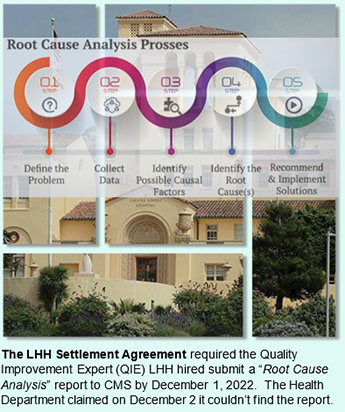
December 2, 2022
Key “Root Cause Analysis” Report Missing in Ation?
Progress on LHH Settlement Agreement Compliance
Costs to Rescue LHH Climb to $20 Million
Keeping Score of LHH’s Progress to Stay Open
by Patrick Monette-Shaw
Looming deadlines are worrisome, because keeping Laguna Honda Hospital (LHH) open is contingent on SFDPH complying with terms in the LHH Settlement Agreement, including meeting deadlines.
But first, a clarification is in order to my October 21 article, “LHH Settlement Agreement Requires Re-Certification,” that I submitted for publication just before going in for surgery on October 24.
I had written:
“Clearly, the settlement agreement [was] being rammed through the approval process without members of the public being able to see, or weigh in on, full details of the agreement, which [had been] shrouded in secrecy.”
 When the San Francisco Health Commission approved terms of the proposed settlement agreement during its October 18 meeting, it is still not known whether the Commission had agreed to approving a summary of the framework terms in principle presented to it by the City Attorney’s Office during a 60-minute closed session on October 18, or if the Commission had seen the full details — or any — of the final language in the 23-page Settlement Agreement. Reading, digesting, and comprehending 23 pages of legal text within 60 minutes would be remarkable.
When the San Francisco Health Commission approved terms of the proposed settlement agreement during its October 18 meeting, it is still not known whether the Commission had agreed to approving a summary of the framework terms in principle presented to it by the City Attorney’s Office during a 60-minute closed session on October 18, or if the Commission had seen the full details — or any — of the final language in the 23-page Settlement Agreement. Reading, digesting, and comprehending 23 pages of legal text within 60 minutes would be remarkable.
One of my Westside Observer colleagues, Terry Palmer — who is a retired MD specializing in geriatric medicine and is a Board member of San Francisco’s Gray Panthers — managed to obtain an electronic copy of the LHH Settlement Agreement on October 21 from San Francisco City Attorney David Chiu’s 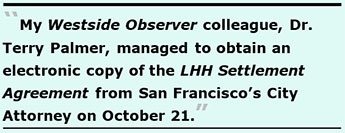 office by e-mail on the same date I had submitted my article.
office by e-mail on the same date I had submitted my article.
Palmer had submitted an e-mail to the City Attorney’s Office (CAO) at 1:20 p.m. on October 21 complaining that as of that date “the actual terms of the settlement have not yet been released,” despite the fact that Chiu had reportedly participated in a Zoom meeting with members of the Gray Panthers and other interested observers on Monday, October 17.
Palmer’s persistence paid off. At 5:01 p.m. on Friday October 21, the CAO finally provided a copy of the Settlement Agreement in PDF file format to Palmer by e-mail, notably after closing time just before the weekend. That was the first time members of the public were allowed to see it — after the Health Commission had already agreed on October 18 to approve the Settlement.
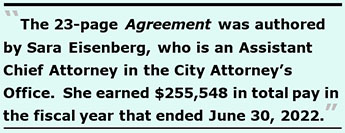 Of interest, metadata of the Settlement Agreement PDF file provided some information. The 23-page Agreement was created on October 12 and modified at 3:56 p.m. in the afternoon of October 21, before it was provided to Palmer. The document’s author was listed as Sara Eisenberg, who is an Assistant Chief Attorney in the City Attorney’s Office. Public records show Eisenberg earned $255,548 in total pay (excluding fringe benefits) during the fiscal year ending June 30, 2022. Eisenberg is listed in the Agreement as being a contact person to receive correspondence and documents from the Centers for Medicare and Medicaid Services (CMS) and California Department of Public Health (CDPH) regarding the Settlement.
Of interest, metadata of the Settlement Agreement PDF file provided some information. The 23-page Agreement was created on October 12 and modified at 3:56 p.m. in the afternoon of October 21, before it was provided to Palmer. The document’s author was listed as Sara Eisenberg, who is an Assistant Chief Attorney in the City Attorney’s Office. Public records show Eisenberg earned $255,548 in total pay (excluding fringe benefits) during the fiscal year ending June 30, 2022. Eisenberg is listed in the Agreement as being a contact person to receive correspondence and documents from the Centers for Medicare and Medicaid Services (CMS) and California Department of Public Health (CDPH) regarding the Settlement.
It’s not known whether Eisenberg created and authored the document herself on behalf of the City Attorney and LHH, or whether it had been created by legal staff working in either CDPH or in CMS. It’s also not known whether various iterations of the Agreement were exchanged among the three agencies during development of the settlement terms.
Looming Settlement Agreement Deadlines
My other Westside Observer colleague, Dr. Derek Kerr, wrote a terrific article in November outlining the regulatory straitjacket LHH was placed in, given terms in the Settlement Agreement and contractual deadlines imposed.
“Quality Improvement Expert” Deadline November 4
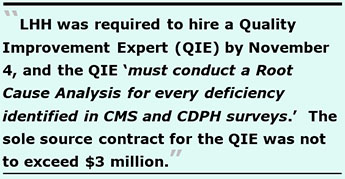 Kerr reported that LHH was required to hire a Quality Improvement Expert (QIE) LHH by November 4, and the QIE “must conduct a ‘Root Cause Analysis’ for every deficiency identified in CMS and CDPH surveys” since near-fatal patient overdoses in July 2021. CMS and CDPH had cited LHH for 26 deficiencies between October 14, 2021 and April 13, 2022 alone.
Kerr reported that LHH was required to hire a Quality Improvement Expert (QIE) LHH by November 4, and the QIE “must conduct a ‘Root Cause Analysis’ for every deficiency identified in CMS and CDPH surveys” since near-fatal patient overdoses in July 2021. CMS and CDPH had cited LHH for 26 deficiencies between October 14, 2021 and April 13, 2022 alone.
LHH and SFDPH were allowed to pick a QIE, but it was contingent on LHH submitting the qualifications of the QIE to CMS and CMS’ subsequent determination of whether the QIE was qualified to perform the tasks required under the Settlement Agreement before CMS would grant approval for the QIE chosen.
The Board of Supervisors approved the LHH Settlement Agreement on First Reading on November 1 and on Second Reading a week later on November 8, which authorized the San Francisco Department of Public Health (SFDPH) to enter into a sole source contract with a QIE approved by CMS in an amount not to exceed three million dollars, for a one-year and three-month term through December 31, 2023 to provide skilled nursing quality improvement services approved by CMS.
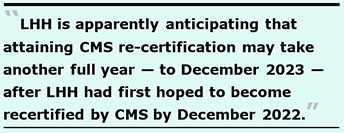 LHH may apparently be anticipating that attaining CMS re-certification is going to take another full year — to December 2023 — after LHH had first hoped to reapply in September 2022 and become recertified by CMS by December 2022.
LHH may apparently be anticipating that attaining CMS re-certification is going to take another full year — to December 2023 — after LHH had first hoped to reapply in September 2022 and become recertified by CMS by December 2022.
“Root Cause Analysis” Deadline December 1
Among other things, the Root Cause Analysis was supposed to determine “the factors that resulted in CMS concluding that LHH violated a federal regulation and to ensure long-term substantial compliance in the future with federal [CMS} participation requirements” [paragraph 10 on page 10 of the Settlement Agreement].
The Analysis was specifically supposed to address the deficiencies that involved: ensuring that all LHH residents receive appropriate and sufficient supervision and that LHH implements appropriate interventions to keep LHH residents safe from accident hazards, including illegal drug use; developing comprehensive care plans and completing comprehensive assessments of all residents; ensuring that residents admitted to LHH with limited ranges of motion receive appropriate treatment and services to increase their range of motion, or prevent further decrease in their range of motion; ensuring that pain management is provided to residents who require those services; establishing and maintaining an infection prevention and control program; and other deficiencies.
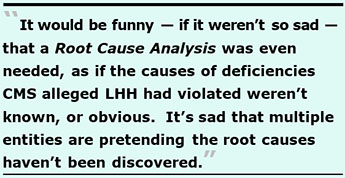 It would be funny — if it weren’t so sad — that a Root Cause Analysis was even needed, as if the causes of the deficiencies CMS alleged LHH had violated weren’t known, or obvious. What’s sad is that SFDPH, LHH acting CEO Roland Pickens, the Health Commission, and even CDPH and CMS are all acting like — or pretending — the root causes haven’t been discovered. For starters, here are a couple of clues: 1) LHH seems to have violated its own admission policies, 2) The Flow Project routed inappropriate SFGH behavioral-health patients to LHH where they wouldn’t receive the appropriate mental health and substance abuse help that they need, and 3) When LHH flunked its April 14, 2022 CPDH inspection survey, State inspectors had observed 15 LHH nursing staff not following COVID infection precautions. As late as October LHH was still struggling with nursing staff around infection control compliance following the first Mock Survey preparing for CMS re-inspections.
It would be funny — if it weren’t so sad — that a Root Cause Analysis was even needed, as if the causes of the deficiencies CMS alleged LHH had violated weren’t known, or obvious. What’s sad is that SFDPH, LHH acting CEO Roland Pickens, the Health Commission, and even CDPH and CMS are all acting like — or pretending — the root causes haven’t been discovered. For starters, here are a couple of clues: 1) LHH seems to have violated its own admission policies, 2) The Flow Project routed inappropriate SFGH behavioral-health patients to LHH where they wouldn’t receive the appropriate mental health and substance abuse help that they need, and 3) When LHH flunked its April 14, 2022 CPDH inspection survey, State inspectors had observed 15 LHH nursing staff not following COVID infection precautions. As late as October LHH was still struggling with nursing staff around infection control compliance following the first Mock Survey preparing for CMS re-inspections.
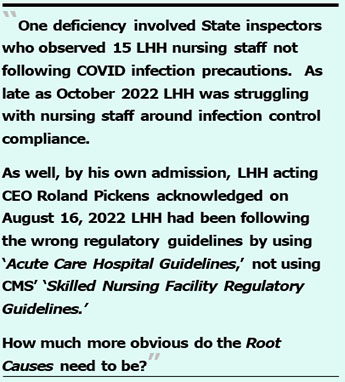 Also obvious are the decades of mismanagement of LHH by SFGH and SFDPH managers lacking experience in skilled nursing facilities who were brought in to meddle with LHH’s operations.
Also obvious are the decades of mismanagement of LHH by SFGH and SFDPH managers lacking experience in skilled nursing facilities who were brought in to meddle with LHH’s operations.
For example, the Westside Observer reported last September that by his own admission, LHH acting CEO Roland Pickens — himself brought in from SFDPH’s upper management — clearly acknowledged to the Health Commission on August 16, 2022 that LHH had been following the wrong regulatory guidelines by using California’s Title 22 “Acute Care Hospital Guidelines,” not using CMS’ “Skilled Nursing Facility Regulatory Guidelines” and CMS’ Critical Element Pathways (CEP’s). Pickens clearly stated on August 16 that “had we been utilizing CEP’s in the past, perhaps the facility could have been more in line with regulatory compliance …” and might not have been slapped with 26 deficiencies and found in noncompliance by CMS, which led to LHH’s decertification.
How much more obvious do the Root Causes need to be?
As a reminder, the Flow Project was created 18 years ago in 2004 as a budget-cutting move to transfer SFGH patients with mental health problems to LHH, with disastrous results ever since. Mixing, also known as “cohorting,” different patient populations — such as mixing frail elderly patients with Alzheimer’s and other dementias in with younger able-bodied patients with substance abuse and mental health diagnoses — in a single facility is not a good idea, precisely because both patient populations don’t receive the appropriate level of care that they need. CMS’ focus on LHH appear to be based on CMS’ potential concerns with cohorting different patient populations in a single facility.
When it comes to cohorting the two patient populations in a single facility, for its part SFDPH does not want to admit that it has grossly violated long-standing nursing home regulations with the Flow Project for nearly two decades, and simultaneously loathe to admit that it understaffed, did not train, and could not retain staff at LHH to provide behavioral health care.
 Along with documenting the root causes of each deficiency, the Analysis report must include recommendations for changes and improvements necessary to achieve and maintain CMS regulatory compliance going forward. The Settlement Agreement required in paragraph 10-c on page 13 that the QIE submit it’s Root Cause Analysis and recommendations report in writing to CMS no later than December 1.
Along with documenting the root causes of each deficiency, the Analysis report must include recommendations for changes and improvements necessary to achieve and maintain CMS regulatory compliance going forward. The Settlement Agreement required in paragraph 10-c on page 13 that the QIE submit it’s Root Cause Analysis and recommendations report in writing to CMS no later than December 1.
There are at least three problems with the QIE and Root Cause Analysis report.
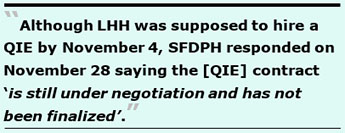 First, although LHH was supposed to hire a QIE by November 4, SFDPH responded on November 28 to a Westside Observer public records request placed on November 22 for the name of the QIE that LHH had hired and the contract awarded to the QIE, saying the contract “agreement is still under negotiation and has not been finalized, thus it is exempt from disclosure under S.F. Administrative Code §67.24(e)(1).” SFDPH initially failed to even name the company it had hired to be its QIE, and failed to respond to a follow-up request seeking the name of the company. [The Settlement Agreement specifically stipulated: “No one who currently or in the past 24 months has been an employee of LHH or has any other conflict of interest under applicable laws, may act as a QIE pursuant to this Agreement.”]
First, although LHH was supposed to hire a QIE by November 4, SFDPH responded on November 28 to a Westside Observer public records request placed on November 22 for the name of the QIE that LHH had hired and the contract awarded to the QIE, saying the contract “agreement is still under negotiation and has not been finalized, thus it is exempt from disclosure under S.F. Administrative Code §67.24(e)(1).” SFDPH initially failed to even name the company it had hired to be its QIE, and failed to respond to a follow-up request seeking the name of the company. [The Settlement Agreement specifically stipulated: “No one who currently or in the past 24 months has been an employee of LHH or has any other conflict of interest under applicable laws, may act as a QIE pursuant to this Agreement.”]
During the November 8, 2022 meeting of the LHH-JCC (a Joint Conference Subcommittee of the Health Commission consisting of three Health Commissioners and senior managers of LHH), LHH’s acting CEO Roland Pickens presented the Executive Team report, which included a miserly two-sentence bullet point that barely mentioned in passing that “LHH anticipates working with a Quality Improvement Expert to complete a root cause analysis,” but didn’t mention the name of the company appointed to be the QIE. [In hindsight, Pickens’ choice of wording using “anticipates” was odd, because by November 8 the Settlement Agreement had stipulated that a QIE was supposed to have been hired by November 4 and the full Settlement Agreement had been passed on First reading by the Board of Supervisors on November 1.]
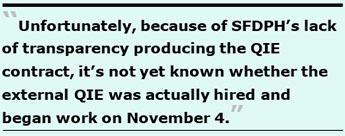 Unfortunately, because of SFDPH’s lack of transparency producing the QIE contract, it’s not yet known whether the external QIE was actually hired and began work on November 4, or what the QIE contract states, if anything, about what the QIE’s role is with the Root Cause Analysis.
Unfortunately, because of SFDPH’s lack of transparency producing the QIE contract, it’s not yet known whether the external QIE was actually hired and began work on November 4, or what the QIE contract states, if anything, about what the QIE’s role is with the Root Cause Analysis.
Second, it appears the “Root Cause Analysis” written report may not have been submitted to CMS by the December 1 deadline. The Westside Observer had placed another records request to SFDPH on December 1 seeking the QIE’s Root Cause Analysis report and recommendations due to CMS on December 1.
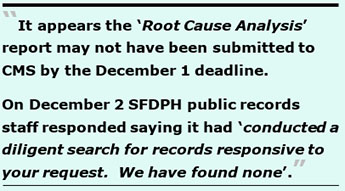 Shockingly, on December 2 SFDPH public records staff responded surprisingly promptly, saying: “[SFDPH] conducted a diligent search for records responsive to your request. We have found none. Accordingly, we have no records to produce in response to your request.” For good measure SFDPH added:
Shockingly, on December 2 SFDPH public records staff responded surprisingly promptly, saying: “[SFDPH] conducted a diligent search for records responsive to your request. We have found none. Accordingly, we have no records to produce in response to your request.” For good measure SFDPH added:
“As of today, SFDPH does not have possession, custody, or control of the record responsive to your request. You are free to submit a records request to CMS to obtain a copy of the record you seek.”
If LHH had requested and gotten an extension to CMS’ December 1 deadline, or if CMS had agreed to revise the Settlement Agreement to remove the requirement to produce and submit a Root Cause Analysis, shouldn’t SFDPH public records staff have simply said so? Wouldn’t a “diligent” search for records have turned up either of the two possibilities? Alternatively, why would SFDPH deflect by suggesting that the Westside Observer should submit a records request to CMS to obtain a document SFDPH or LHH should have in their possession, or should have retained? That’s very odd.
 The Settlement Agreement states in paragraph 10-c that “The QIE will submit the Report in writing to CMS,” with a clear — albeit somewhat elliptical — inference that by “report,” the Agreement was referring to the “Root Cause Analysis” document. Could SFDPH’s public records staff not have understood that the “analysis” and “report” are one-in-the-same document?
The Settlement Agreement states in paragraph 10-c that “The QIE will submit the Report in writing to CMS,” with a clear — albeit somewhat elliptical — inference that by “report,” the Agreement was referring to the “Root Cause Analysis” document. Could SFDPH’s public records staff not have understood that the “analysis” and “report” are one-in-the-same document?
Interested observers are having a hard time understanding how the QIE LHH hired and is reportedly being paid up to $3 million would have the authority to complete a Root Cause Analysis and submit it directly to CMS without providing a copy of the  Analysis report to LHH, SFDPH, and Ms. Eisenberg in the San Francisco City Attorney’s Office.
Analysis report to LHH, SFDPH, and Ms. Eisenberg in the San Francisco City Attorney’s Office.
One observer wonders if SFDPH is just playing the delay game by not releasing the “Root Cause Analysis” report instead of being fully transparent, taking a page from Donald Trump’s Delaying-Tactics 101 playbook. Does not being transparent tell us that SFDPH and LHH know what they are doing? No, it tells us that they are maintaining secrecy to potentially cover up losing greatly needed skilled nursing facility services in San Francisco.
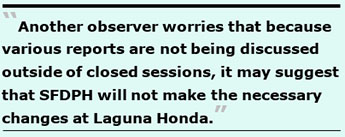 Another observer worries that because the “Root Cause Analysis” report and the “LHH Revised Closure Plan” are not being discussed outside of closed sessions of the Health Commission and Board of Supervisors meetings it may suggest that SFDPH will not make the necessary changes at Laguna Honda going forward.
Another observer worries that because the “Root Cause Analysis” report and the “LHH Revised Closure Plan” are not being discussed outside of closed sessions of the Health Commission and Board of Supervisors meetings it may suggest that SFDPH will not make the necessary changes at Laguna Honda going forward.
A third observer wonders whether SFDPH having been unable to locate the Root Cause Analysis report is going to be a deliberate planned failure to comply with terms of the Settlement Agreement.
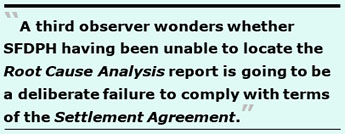 That SFDPH and LHH may not have a copy of the “Root Cause Analysis” is problematic in its own right, because the Settlement Agreement specifically stipulated CMS had reserved the right to require changes to the Root Cause Analysis before CMS approved it, and that CMS would provide a written response to the Root Cause Analysis by December 11, 2022 or the Analysis would be deemed approved [as submitted].
That SFDPH and LHH may not have a copy of the “Root Cause Analysis” is problematic in its own right, because the Settlement Agreement specifically stipulated CMS had reserved the right to require changes to the Root Cause Analysis before CMS approved it, and that CMS would provide a written response to the Root Cause Analysis by December 11, 2022 or the Analysis would be deemed approved [as submitted].
Given SFDPH’s history of flouting San Francisco’s Sunshine Ordinance to delay release of public records — particularly its delay releasing the LHH Settlement Agreement and other records involving the potential closure of LHH — the Westside Observer had already submitted a concurrent FOIA request to CMS dated December 1 to obtain the “Root Cause Analysis” report, even before SFDPH lamely suggested we were “free to submit a records request to CMS.”
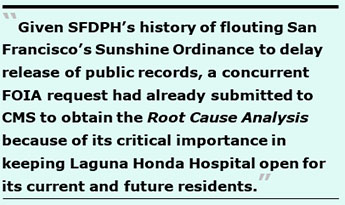 The FOIA request was placed given the critical importance of keeping Laguna Honda Hospital open for its current and future residents. Hopefully, CMS will produce the Root Cause Analysis SFDPH claimed it didn’t have possession, custody, or control of.
The FOIA request was placed given the critical importance of keeping Laguna Honda Hospital open for its current and future residents. Hopefully, CMS will produce the Root Cause Analysis SFDPH claimed it didn’t have possession, custody, or control of.
By the time you read this article, there may be just five or six days to CMS’ internal December 11 deadline to approve the Root Cause Analysis, or request changes that must be made. How will LHH be able to revise the Analysis if CMS requests changes, if the document could not be located as SFDPH claimed?
The “Action Plan”
Third, the Settlement Agreement specifically stipulated in paragraph 11 on page 13 that the external QIE(s) will assist LHH in developing an Action Plan based on, and to respond to, the findings and recommendations presented in the Root Cause Analysis report. The Action Plan must include improvement solutions identified as recommendations. LHH is supposed to submit the Action Plan to CMS and CDPH for review and approval no later than January 6, 2023.
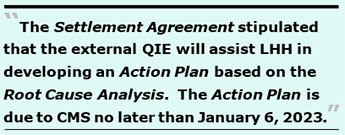 CMS will also have final approval of the proposed Action Plan. CMS has until January 17 to provide initial comments about the Plan to LHH, or the Action Plan will be deemed to be approved. If CMS does request any changes to the Action Plan, LHH and its QIE will have ten days from receipt of CMS’ proposed revisions to make the requested changes. Once CMS approves the final Action Plan, LHH will cooperate with the QIE to promptly implement the Plan. which must be fully implemented by May 13, 2023. But if LHH doesn’t agree to an Action Plan CMS approves, or if LHH refuses to implement any material aspect of the Plan without good cause, CMS may terminate the entire Settlement Agreement and again discontinue discretionary Federal funding to Laguna Honda Hospital.
CMS will also have final approval of the proposed Action Plan. CMS has until January 17 to provide initial comments about the Plan to LHH, or the Action Plan will be deemed to be approved. If CMS does request any changes to the Action Plan, LHH and its QIE will have ten days from receipt of CMS’ proposed revisions to make the requested changes. Once CMS approves the final Action Plan, LHH will cooperate with the QIE to promptly implement the Plan. which must be fully implemented by May 13, 2023. But if LHH doesn’t agree to an Action Plan CMS approves, or if LHH refuses to implement any material aspect of the Plan without good cause, CMS may terminate the entire Settlement Agreement and again discontinue discretionary Federal funding to Laguna Honda Hospital.
Again, by the time you read this on December 6 or so, there will be roughly 30 calendar days before the Action Plan is due to CMS on January 6, of which at least five days will be lost to the Christmas and New Year holidays.
As Dr. Kerr noted, the Settlement Agreement “includes many other technical requirements that will severely challenge LHH managers and staff. Each of these requirements creates potential pitfalls and penalties,” leaving LHH little wiggle room.
Costs to Rescue LHH Rise to $20 Million
As I wrote in the Westside Observer in early September, costs of rescuing LHH was thought to have been capped at just over $15 million, mostly for three consulting contracts. One contract was with Health Management Associates (HMA), for $3.7 million, and a second contract was with Tryfacta, Inc. to provide LHH with as-needed staffing. The third contract was with Health Services Advisory Group (HSAG) was initially for $1.8 million, but subsequently received a first amendment increasing the contract by $5.2 million to a total of just under $7 million.
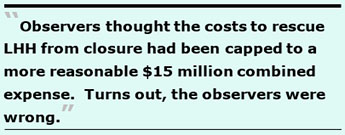 The HSAG contract was also issued as a sole-source contract based on the firm’s experience as CMS’ federally-assigned Quality Improvement Organization (QIO) for California. You have to wonder whether CMS is paying HSAG to be its QIO for California, and if that portends a semblance of dual loyalty to LHH and CMS on the part of HSAG.
The HSAG contract was also issued as a sole-source contract based on the firm’s experience as CMS’ federally-assigned Quality Improvement Organization (QIO) for California. You have to wonder whether CMS is paying HSAG to be its QIO for California, and if that portends a semblance of dual loyalty to LHH and CMS on the part of HSAG.
The three contracts and the single amendment totaled $14.27 million, but SFDPH had asked San Francisco’s Board of Supervisors to allow it to increase the three contracts to $10 million each, and allow SFDPH to extend the three contracts to terms of 10 years each without needing to return to the Board of Supervisors for contract extension permission.
 The Board balked at the ten-year terms, holding them to their initial terms through the end of December 2022 ( except the HMA contract, which runs through Jube 2023), and prevented each of the three contracts from ballooning to $10 million apiece.
The Board balked at the ten-year terms, holding them to their initial terms through the end of December 2022 ( except the HMA contract, which runs through Jube 2023), and prevented each of the three contracts from ballooning to $10 million apiece.
So, observers thought the costs to rescue LHH from closure had been capped to a more reasonable $15 million combined expense. Turns out, the observers were wrong.
 As noted, the LHH Settlement Agreement approved on second reading by the Board of Supervisors on November 8 authorized LHH to enter into a sole source contract to hire a Quality Improvement Expert at a cost of up to $3 million. Because SFDPH is refusing to release public records providing the contract for the QIE, we don’t yet know how close that contract will be to the $3 million authorized.
As noted, the LHH Settlement Agreement approved on second reading by the Board of Supervisors on November 8 authorized LHH to enter into a sole source contract to hire a Quality Improvement Expert at a cost of up to $3 million. Because SFDPH is refusing to release public records providing the contract for the QIE, we don’t yet know how close that contract will be to the $3 million authorized.
Then, on November 15, the Board of Supervisors agreed to award a contract First Amendment of $2 million to HMA, pushing its contract to a total of $5.86 million, as shown in Table 1, with no change to the contract term through June 30, 2023.
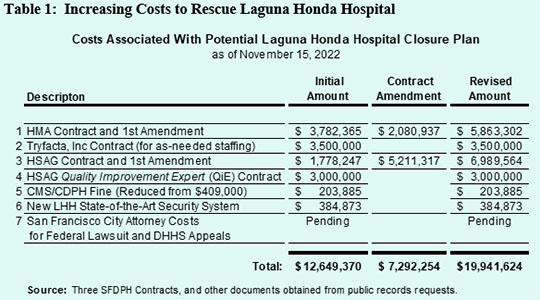
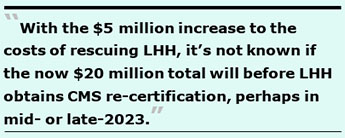 The HMA contract amendment involves minor expansion of two of the initial contract scope of deliverables, including development and integration of a comprehensive education rollout plan, and infection control program enhancements. Why that’s worth an additional two million dollars isn’t clear.
The HMA contract amendment involves minor expansion of two of the initial contract scope of deliverables, including development and integration of a comprehensive education rollout plan, and infection control program enhancements. Why that’s worth an additional two million dollars isn’t clear.
With the $5 million increase to the costs of rescuing LHH, it’s not known if the now $20 million total will continue to rise before LHH obtains CMS re-certification, perhaps in mid- or late-2023. What is known is that the costs of City Attorney legal time and expenses that will be charged back to LHH and SFDPH may likely involve another million dollars more.
Update on LHH’s So-Called “Revised Closure Plan”
Again, presumably the Health Commission and Board of Supervisors should have been aware that the LHH Revised Closure Plan was mentioned 19 times in the Settlement Agreement. And presumably, the seven members of the Health Commission and 11 members of the Board of Supervisors should have asked to see a copy of the revised Plans to close LHH before agreeing to accept the terms of the Settlement Agreement.
But as of November 28, when asked again to provide a copy of the Revised Closure Plan, SFDPH Public Records Request staff continue to insist the Revised Plan is confidential attorney-client privileged under S.F. Admin. Code §67.24 and California Government Code §6254(k), and it will only be provided as a courtesy after it is formally submitted to CDPH (which has presumably seen it as a signatory to the Settlement Agreement).
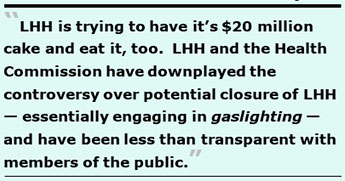 LHH, through SFDPH, is attempting to have it’s $20 million cake and eat it, too. LHH and the Health Commission have downplayed the controversy over potential closure of LHH — essentially engaging in gaslighting — and have been less than transparent with members of the public about whether various deadlines swirling around the LHH Settlement Agreement are being met.
LHH, through SFDPH, is attempting to have it’s $20 million cake and eat it, too. LHH and the Health Commission have downplayed the controversy over potential closure of LHH — essentially engaging in gaslighting — and have been less than transparent with members of the public about whether various deadlines swirling around the LHH Settlement Agreement are being met.
All along, SFDPH and LHH have not been showing us that know what they are doing. It’s long past time for them to be more honest and transparent with the public that they serve!
In order to keep LHH open, observers had been hoping LHH and SFDPH were meeting CMS deadlines. News that surfaced on December 2 that the Root Cause Analysis report due to CMS on December 1 was missing in action at SFDPH is troubling.
 Postscript: December 15
Postscript: December 15
On December 9, SFDPH finally revealed that the QIE contract was awarded to HSAG, 16 days after initially failing on Novmber 23 to provide the name of the company. The multiple contracts awarded to HSAG now total $9,989,564 — just $10,436 shy of the $10 million SFDPH had requested the Board of Supervisors approve.
Monette-Shaw is a columnist for San Francisco’s Westside Observer newspaper, and a retired City employee. He received a James Madison Freedom of Information Award in the “Advocacy” category from the Society of Professional Journalists–Northern California Chapter in 2012. He’s a member of the California First Amendment Coalition (FAC) and the ACLU. Contact him at monette-shaw@westsideobserver.com.
Top
 When the San Francisco Health Commission approved terms of the proposed settlement agreement during its October 18 meeting, it is still not known whether the Commission had agreed to approving a summary of the framework terms in principle presented to it by the City Attorney’s Office during a 60-minute closed session on October 18, or if the Commission had seen the full details — or any — of the final language in the 23-page Settlement Agreement. Reading, digesting, and comprehending 23 pages of legal text within 60 minutes would be remarkable.
When the San Francisco Health Commission approved terms of the proposed settlement agreement during its October 18 meeting, it is still not known whether the Commission had agreed to approving a summary of the framework terms in principle presented to it by the City Attorney’s Office during a 60-minute closed session on October 18, or if the Commission had seen the full details — or any — of the final language in the 23-page Settlement Agreement. Reading, digesting, and comprehending 23 pages of legal text within 60 minutes would be remarkable.
 office by e-mail on the same date I had submitted my article.
office by e-mail on the same date I had submitted my article.  Of interest, metadata of the Settlement Agreement PDF file provided some information. The 23-page Agreement was created on October 12 and modified at 3:56 p.m. in the afternoon of October 21, before it was provided to Palmer. The document’s author was listed as Sara Eisenberg, who is an Assistant Chief Attorney in the City Attorney’s Office. Public records show Eisenberg earned $255,548 in total pay (excluding fringe benefits) during the fiscal year ending June 30, 2022. Eisenberg is listed in the Agreement as being a contact person to receive correspondence and documents from the Centers for Medicare and Medicaid Services (CMS) and California Department of Public Health (CDPH) regarding the Settlement.
Of interest, metadata of the Settlement Agreement PDF file provided some information. The 23-page Agreement was created on October 12 and modified at 3:56 p.m. in the afternoon of October 21, before it was provided to Palmer. The document’s author was listed as Sara Eisenberg, who is an Assistant Chief Attorney in the City Attorney’s Office. Public records show Eisenberg earned $255,548 in total pay (excluding fringe benefits) during the fiscal year ending June 30, 2022. Eisenberg is listed in the Agreement as being a contact person to receive correspondence and documents from the Centers for Medicare and Medicaid Services (CMS) and California Department of Public Health (CDPH) regarding the Settlement. Kerr reported that LHH was required to hire a Quality Improvement Expert (QIE) LHH by November 4, and the QIE “must conduct a ‘Root Cause Analysis’ for every deficiency identified in CMS and CDPH surveys” since near-fatal patient overdoses in July 2021. CMS and CDPH had cited LHH for 26 deficiencies between October 14, 2021 and April 13, 2022 alone.
Kerr reported that LHH was required to hire a Quality Improvement Expert (QIE) LHH by November 4, and the QIE “must conduct a ‘Root Cause Analysis’ for every deficiency identified in CMS and CDPH surveys” since near-fatal patient overdoses in July 2021. CMS and CDPH had cited LHH for 26 deficiencies between October 14, 2021 and April 13, 2022 alone. LHH may apparently be anticipating that attaining CMS re-certification is going to take another full year — to December 2023 — after LHH had first hoped to reapply in September 2022 and become recertified by CMS by December 2022.
LHH may apparently be anticipating that attaining CMS re-certification is going to take another full year — to December 2023 — after LHH had first hoped to reapply in September 2022 and become recertified by CMS by December 2022. It would be funny — if it weren’t so sad — that a Root Cause Analysis was even needed, as if the causes of the deficiencies CMS alleged LHH had violated weren’t known, or obvious. What’s sad is that SFDPH, LHH acting CEO Roland Pickens, the Health Commission, and even CDPH and CMS are all acting like — or pretending — the root causes haven’t been discovered. For starters, here are a couple of clues: 1) LHH seems to have violated its own admission policies, 2) The Flow Project routed inappropriate SFGH behavioral-health patients to LHH where they wouldn’t receive the appropriate mental health and substance abuse help that they need, and 3) When LHH flunked its April 14, 2022 CPDH inspection survey, State inspectors had
It would be funny — if it weren’t so sad — that a Root Cause Analysis was even needed, as if the causes of the deficiencies CMS alleged LHH had violated weren’t known, or obvious. What’s sad is that SFDPH, LHH acting CEO Roland Pickens, the Health Commission, and even CDPH and CMS are all acting like — or pretending — the root causes haven’t been discovered. For starters, here are a couple of clues: 1) LHH seems to have violated its own admission policies, 2) The Flow Project routed inappropriate SFGH behavioral-health patients to LHH where they wouldn’t receive the appropriate mental health and substance abuse help that they need, and 3) When LHH flunked its April 14, 2022 CPDH inspection survey, State inspectors had  Also obvious are the decades of mismanagement of LHH by SFGH and SFDPH managers lacking experience in skilled nursing facilities who were brought in to meddle with LHH’s operations.
Also obvious are the decades of mismanagement of LHH by SFGH and SFDPH managers lacking experience in skilled nursing facilities who were brought in to meddle with LHH’s operations.  Along with documenting the root causes of each deficiency, the Analysis report must include recommendations for changes and improvements necessary to achieve and maintain CMS regulatory compliance going forward. The Settlement Agreement required in paragraph 10-c on page 13 that the QIE submit it’s Root Cause Analysis and recommendations report in writing to CMS no later than December 1.
Along with documenting the root causes of each deficiency, the Analysis report must include recommendations for changes and improvements necessary to achieve and maintain CMS regulatory compliance going forward. The Settlement Agreement required in paragraph 10-c on page 13 that the QIE submit it’s Root Cause Analysis and recommendations report in writing to CMS no later than December 1. First, although LHH was supposed to hire a QIE by November 4, SFDPH responded on November 28 to a Westside Observer public records request placed on November 22 for the name of the QIE that LHH had hired and the contract awarded to the QIE, saying the contract “agreement is still under negotiation and has not been finalized, thus it is exempt from disclosure under S.F. Administrative Code §67.24(e)(1).” SFDPH initially failed to even name the company it had hired to be its QIE, and failed to respond to a follow-up request seeking the name of the company. [The Settlement Agreement specifically stipulated: “No one who currently or in the past 24 months has been an employee of LHH or has any other conflict of interest under applicable laws, may act as a QIE pursuant to this Agreement.”]
First, although LHH was supposed to hire a QIE by November 4, SFDPH responded on November 28 to a Westside Observer public records request placed on November 22 for the name of the QIE that LHH had hired and the contract awarded to the QIE, saying the contract “agreement is still under negotiation and has not been finalized, thus it is exempt from disclosure under S.F. Administrative Code §67.24(e)(1).” SFDPH initially failed to even name the company it had hired to be its QIE, and failed to respond to a follow-up request seeking the name of the company. [The Settlement Agreement specifically stipulated: “No one who currently or in the past 24 months has been an employee of LHH or has any other conflict of interest under applicable laws, may act as a QIE pursuant to this Agreement.”] Unfortunately, because of SFDPH’s lack of transparency producing the QIE contract, it’s not yet known whether the external QIE was actually hired and began work on November 4, or what the QIE contract states, if anything, about what the QIE’s role is with the Root Cause Analysis.
Unfortunately, because of SFDPH’s lack of transparency producing the QIE contract, it’s not yet known whether the external QIE was actually hired and began work on November 4, or what the QIE contract states, if anything, about what the QIE’s role is with the Root Cause Analysis.
 The Settlement Agreement states in paragraph 10-c that “The QIE will submit the Report in writing to CMS,” with a clear — albeit somewhat elliptical — inference that by “report,” the Agreement was referring to the “Root Cause Analysis” document. Could SFDPH’s public records staff not have understood that the “analysis” and “report” are one-in-the-same document?
The Settlement Agreement states in paragraph 10-c that “The QIE will submit the Report in writing to CMS,” with a clear — albeit somewhat elliptical — inference that by “report,” the Agreement was referring to the “Root Cause Analysis” document. Could SFDPH’s public records staff not have understood that the “analysis” and “report” are one-in-the-same document? Analysis report to LHH, SFDPH, and Ms. Eisenberg in the San Francisco City Attorney’s Office.
Analysis report to LHH, SFDPH, and Ms. Eisenberg in the San Francisco City Attorney’s Office. Another observer worries that because the “Root Cause Analysis” report and the “LHH Revised Closure Plan” are not being discussed outside of closed sessions of the Health Commission and Board of Supervisors meetings it may suggest that SFDPH will not make the necessary changes at Laguna Honda going forward.
Another observer worries that because the “Root Cause Analysis” report and the “LHH Revised Closure Plan” are not being discussed outside of closed sessions of the Health Commission and Board of Supervisors meetings it may suggest that SFDPH will not make the necessary changes at Laguna Honda going forward. That SFDPH and LHH may not have a copy of the “Root Cause Analysis” is problematic in its own right, because the Settlement Agreement specifically stipulated CMS had reserved the right to require changes to the Root Cause Analysis before CMS approved it, and that CMS would provide a written response to the Root Cause Analysis by December 11, 2022 or the Analysis would be deemed approved [as submitted].
That SFDPH and LHH may not have a copy of the “Root Cause Analysis” is problematic in its own right, because the Settlement Agreement specifically stipulated CMS had reserved the right to require changes to the Root Cause Analysis before CMS approved it, and that CMS would provide a written response to the Root Cause Analysis by December 11, 2022 or the Analysis would be deemed approved [as submitted].  The FOIA request was placed given the critical importance of keeping Laguna Honda Hospital open for its current and future residents. Hopefully, CMS will produce the Root Cause Analysis SFDPH claimed it didn’t have possession, custody, or control of.
The FOIA request was placed given the critical importance of keeping Laguna Honda Hospital open for its current and future residents. Hopefully, CMS will produce the Root Cause Analysis SFDPH claimed it didn’t have possession, custody, or control of.  CMS will also have final approval of the proposed Action Plan. CMS has until January 17 to provide initial comments about the Plan to LHH, or the Action Plan will be deemed to be approved. If CMS does request any changes to the Action Plan, LHH and its QIE will have ten days from receipt of CMS’ proposed revisions to make the requested changes. Once CMS approves the final Action Plan, LHH will cooperate with the QIE to promptly implement the Plan. which must be fully implemented by May 13, 2023. But if LHH doesn’t agree to an Action Plan CMS approves, or if LHH refuses to implement any material aspect of the Plan without good cause, CMS may terminate the entire Settlement Agreement and again discontinue discretionary Federal funding to Laguna Honda Hospital.
CMS will also have final approval of the proposed Action Plan. CMS has until January 17 to provide initial comments about the Plan to LHH, or the Action Plan will be deemed to be approved. If CMS does request any changes to the Action Plan, LHH and its QIE will have ten days from receipt of CMS’ proposed revisions to make the requested changes. Once CMS approves the final Action Plan, LHH will cooperate with the QIE to promptly implement the Plan. which must be fully implemented by May 13, 2023. But if LHH doesn’t agree to an Action Plan CMS approves, or if LHH refuses to implement any material aspect of the Plan without good cause, CMS may terminate the entire Settlement Agreement and again discontinue discretionary Federal funding to Laguna Honda Hospital. The HSAG contract was also issued as a sole-source contract based on the firm’s experience as CMS’ federally-assigned Quality Improvement Organization (QIO) for California. You have to wonder whether CMS is paying HSAG to be its QIO for California, and if that portends a semblance of dual loyalty to LHH and CMS on the part of HSAG.
The HSAG contract was also issued as a sole-source contract based on the firm’s experience as CMS’ federally-assigned Quality Improvement Organization (QIO) for California. You have to wonder whether CMS is paying HSAG to be its QIO for California, and if that portends a semblance of dual loyalty to LHH and CMS on the part of HSAG. The Board balked at the ten-year terms, holding them to their initial terms through the end of December 2022 ( except the HMA contract, which runs through Jube 2023), and prevented each of the three contracts from ballooning to $10 million apiece.
The Board balked at the ten-year terms, holding them to their initial terms through the end of December 2022 ( except the HMA contract, which runs through Jube 2023), and prevented each of the three contracts from ballooning to $10 million apiece. As noted, the LHH Settlement Agreement approved on second reading by the Board of Supervisors on November 8 authorized LHH to enter into a sole source contract to hire a Quality Improvement Expert at a cost of up to $3 million. Because SFDPH is refusing to release public records providing the contract for the QIE, we don’t yet know how close that contract will be to the $3 million authorized.
As noted, the LHH Settlement Agreement approved on second reading by the Board of Supervisors on November 8 authorized LHH to enter into a sole source contract to hire a Quality Improvement Expert at a cost of up to $3 million. Because SFDPH is refusing to release public records providing the contract for the QIE, we don’t yet know how close that contract will be to the $3 million authorized.
 The HMA contract amendment involves minor expansion of two of the initial contract scope of deliverables, including development and integration of a comprehensive education rollout plan, and infection control program enhancements. Why that’s worth an additional two million dollars isn’t clear.
The HMA contract amendment involves minor expansion of two of the initial contract scope of deliverables, including development and integration of a comprehensive education rollout plan, and infection control program enhancements. Why that’s worth an additional two million dollars isn’t clear. LHH, through SFDPH, is attempting to have it’s $20 million cake and eat it, too. LHH and the Health Commission have downplayed the controversy over potential closure of LHH — essentially engaging in gaslighting — and have been less than transparent with members of the public about whether various deadlines swirling around the LHH Settlement Agreement are being met.
LHH, through SFDPH, is attempting to have it’s $20 million cake and eat it, too. LHH and the Health Commission have downplayed the controversy over potential closure of LHH — essentially engaging in gaslighting — and have been less than transparent with members of the public about whether various deadlines swirling around the LHH Settlement Agreement are being met.  Postscript: December 15
Postscript: December 15